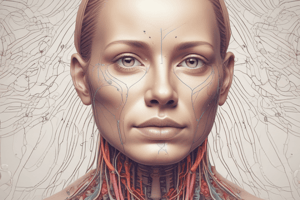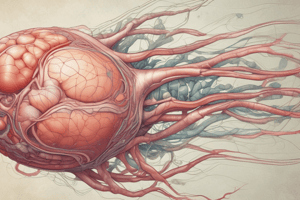Podcast
Questions and Answers
- What is the role of type A spermatogonia in the process of spermatogenesis?
- What is the role of type A spermatogonia in the process of spermatogenesis?
Type A spermatogonia continue to divide.
- What is the function of Sertoli cells in the testes?
- What is the function of Sertoli cells in the testes?
Sertoli cells provide support, protect, and control nutrition for developing sperm.
- What is the significance of the cytoplasmic bridges in spermatogenesis?
- What is the significance of the cytoplasmic bridges in spermatogenesis?
Cytoplasmic bridges connect intercellularly derived cells from a single spermatogonia, facilitating the exchange of materials during sperm development.
- What is the role of the acrosome in spermatozoa?
- What is the role of the acrosome in spermatozoa?
- What are the subdivisions of the sperm tail?
- What are the subdivisions of the sperm tail?
- How do Sertoli cells contribute to the blood-testis barrier?
- How do Sertoli cells contribute to the blood-testis barrier?
- What is the role of Leydig cells in the testes?
- What is the role of Leydig cells in the testes?
- What is the function of the straight tubules in the testes?
- What is the function of the straight tubules in the testes?
- How do testis capillaries differ from typical capillaries?
- How do testis capillaries differ from typical capillaries?
- What surrounds the seminiferous tubules?
- What surrounds the seminiferous tubules?
- What changes occur in the Golgi complex during spermiogenesis?
- What changes occur in the Golgi complex during spermiogenesis?
- What is the fate of type B spermatogonia in spermatogenesis?
- What is the fate of type B spermatogonia in spermatogenesis?
Study Notes
- Spermatogonia, located in the seminiferous tubules, undergo mitosis at sexual maturity.
- Type A spermatogonia continue to divide, while type B spermatogonia differentiate into primary spermatocytes.
- Primary spermatocytes enter meiosis and form secondary spermatocytes and spermatids.
- Cytoplasmic bridges connect intercellularly derived cells (primary and secondary spermatocytes and spermatids) from a single spermatogonia.
- Spermiogenesis involves changes in the Golgi complex, including the production of an acrosome, which covers the nucleus and forms the acrosomal cap.
- Spermatozoa have a head and a tail, with the head's shape determined by the species and the nucleus.
- The sperm tail is subdivided into the neck, middle piece, principal piece, and end piece.
- Sertoli cells, part of the germinal epithelium, provide support, protect, and control nutrition for developing sperm.
- Sertoli cells have a pyramidal shape and contain numerous invaginations where developing spermatids reside.
- Sertoli cells are linked together by occluding zonules, forming the blood-testis barrier, which prevents the entry of substances into the adluminal compartment.
- Interstitial or Leydig cells, found in the stroma, produce testosterone, which is responsible for male sexual characteristics.
- Straight tubules, the initial part of which is composed solely of Sertoli cells, lead to the intratesticular ducts, which transport sperm to the epididymis.
- Testis capillaries are fenestrated, allowing the free passage of macromolecules to the interstitial space.
- The seminiferous tubules are surrounded by connective tissue, nerves, blood and lymphatic vessels.
Studying That Suits You
Use AI to generate personalized quizzes and flashcards to suit your learning preferences.
Related Documents
Description
This lesson covers the anatomy of the male reproductive system, including the testes, genital ducts, accessory glands, and penis. It delves into the functions of the testis as an exocrine and endocrine gland, as well as the surrounding connective tissue.




